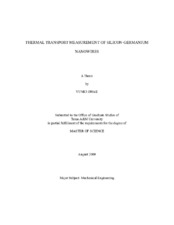| dc.description.abstract | Thermal properties of one dimensional nanostructures are of interest for
thermoelectric energy conversion. Thermoelectric efficiency is related to non dimensional
thermoelectric figure of merit, ZT=S^2 o T/k, where S ,o , k and T are Seebeck
coefficient, electrical conductivity, thermal conductivity and the absolute temperature
respectively. These physical properties are interdependent. Therefore, making materials
with high ZT is a very challenging task. However, nanoscale materials can overcome some
of these limitations. When the size of nanomaterials is comparable to wavelength and mean
free path of energy carriers, especially phonons, size effect contributes to the thermal
conductivity reduction without bringing about major changes in the electrical conductivity
and the Seebeck coefficient. Therefore, the figure of merit ZT can be manipulated. For
example, the thermal conductivities of several silicon nanowires were more than two orders
of magnitude lower than that of bulk silicon values due to the enhanced boundary scattering.
Among the nanoscale semiconductor materials, Silicon-Germanium(SiGe) alloy
nanowire is a promising candidate for thermoelectric materials The thermal conductivities
of SiGe core-shell nanowires with core diameters of 96nm, 129nm and 177nm were
measured using a batch fabricated micro device in a temperature range of 40K-450K. SiGe nanowires used in the experiment were synthesized via the Vapour-Liquid-Solid (VLS)
growth method. The thermal conductivity data was compared with thermal conductivity of
Si and Ge nanowires. The data was compared with SiGe alloy thin film, bulk SiGe,
Si/SixGe1-x superlattice nanowire, Si/Si0.7Ge0.3 superlattice thin film and also with the
thermal conductivity of Si0.5Ge0.5 calculated using the Einstein model. The thermal
conductivities of these SiGe alloy nanowires observed in this work are ~20 times lower
than Si nanowires, ~10 times lower than Ge nanowires, ~3-4 times lower than Si/SixGe1-x
superlattice thin film, Si/SixGe1-x superlattice nanowire and about 3 time lower than bulk
SiGe alloy. The low values of thermal conductivity are majorly due to the effect of alloy
scattering, due to increased boundary scattering as a result of nanoscale diameters, and the
interface diffuse scattering by core-shell effect. The influence of core-shell effect, alloy
scattering and boundary scattering effect in reducing the thermal conductivity of these
nanowires opens up opportunities for tuning thermoelectric properties which can pave way
to thermoelectric materials with high figures of merit in the future. | en |


